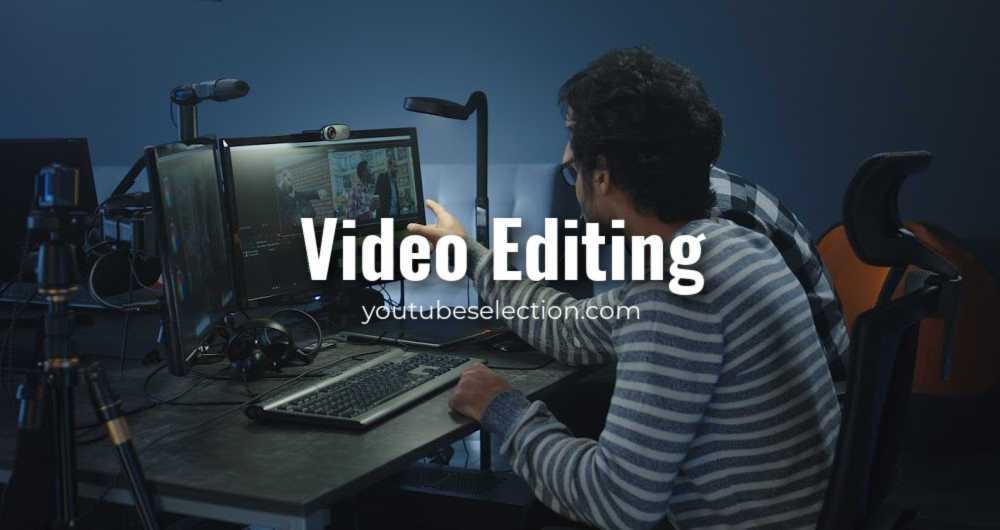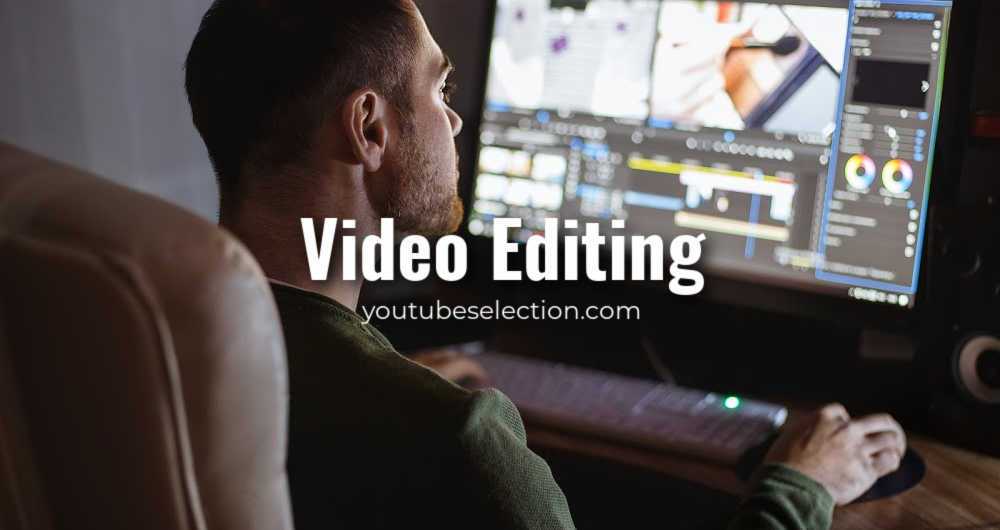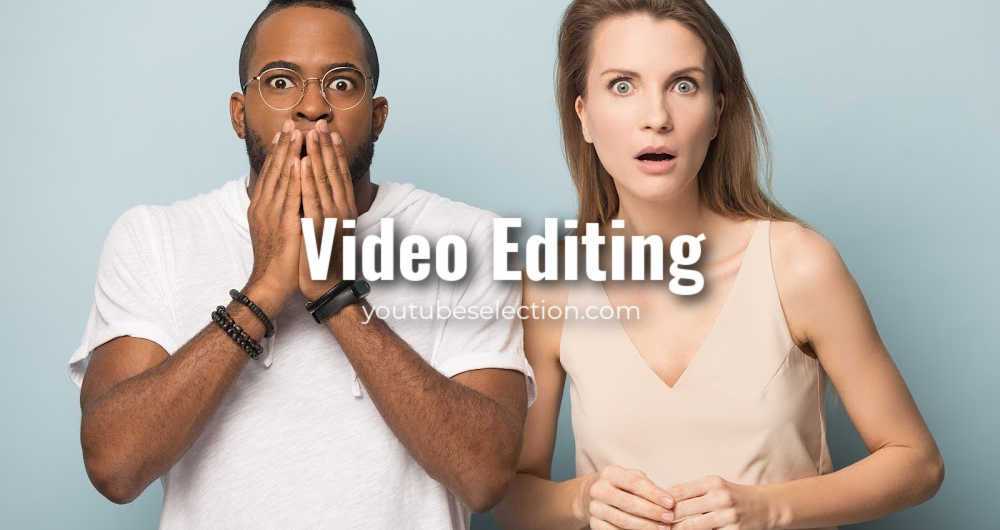Editing is so important when it comes to the quality of your final video.
“We have such short lives and attention spans, and don’t have enough time to put together a video ourselves to see what’s great about it. Editing can make all the difference.”
Mike, Human and YouTube visitor
“Curation, of any kind, adds value”
Doug Peters

Here are the reasons why editing YouTube videos is so significant:
- Allows review of entire content: Shooting a movie is a fast-paced procedure and several aspects can be overlooked. The editing platform allows review of all the content that’s very important to bring it together and generate a coherent image. Unrelated clips are blended to result in a meaningful story.
- Creates the ideal flow: The editing process creates the footage as smooth and organized as possible. Video editors capture the circulation of the footage with the essential cuts, pace and sound to provoke emotion from the audience and produce a stunning film.
- Makes smooth transitions: The editing phase is where important decisions are made regarding color, visual effects, transitions and more. Assorted kinds of transitions like cuts, dissolves, fades, wipes and visual effects enable audiences to comprehend the connections between the scenes and shots on their displays. Transitions join the shots together.
- Ensures smooth stream of audio: Sound editing is as important as editing the visuals. The desire to enrich a movie through its sound has grown exponentially. Audio editing involves assembling all of the noise in the last clip, adjusting the volume levels, and then picking and manipulating the right pieces of audio to accompany the visuals. Audio editing is an important thing to convey the intended message.
- Enhances creative decisions: Skillful video editing enhances the creative choices made from the pre-production stage through to the post-production stage. Editing brings together all the work to generate a unified whole.
The process involves watching the electronic video clips onto a screen and manipulating them with a mouse and a keyboard. To begin with, select a video-editing program.
The best and most professional ones are:
– Premiere Pro
– Final Cut
– Sony Vegas
– Pinnacle Studio
Less professional but simple to use and still effective:
– iMovie
– Camtasia
To find more editors check out our page with the best edititing tools: Best Video Editing Assets for YouTube!
So… now dip the movie in your timeline and trim it. You can make the video briefer or cut out bits you don’t need. You can add transitions like fades or swipes between pictures. The final result should be one, seamless video that conveys your message.
After editing and assembling your movie into a cohesive whole, add special effects. However, take care to see that the specific effects you utilize enhance your story and don’t draw attention away from the key message. Then pick a suitable file format to upload your video.
Don’t forget to render your movie in high resolution. When you are editing your movie, use a 16:9 ratio widescreen format and then present your file in either 720p or 1080i high definition. This will make sure that your video will look great even if it is viewed on a big-screen, high-definition TV.
YouTube Video, from start to end
A YouTube video is not like any other. It is created by 3 parts, all of them being important.
Part 1. Video Introduction (Video Intro)
Introduce the topic you are going to cover in your video as quickly as possible. Most people who search for and find your video won’t know who you are before they watch it. They want to learn about the topic, not about you. Keep your introduction brief and tell them exactly what the outcome of the video.
Part 2. Main Content
Share your best advice on your chosen topic. If you can be entertaining or inspiring at the same time, great. But above all, share practical advice (no fluff!) that answers a specific question, helps your audience solve a problem, or achieve a specific result. If it’s a funny video, make sure you have no boring, dead moments. Keep it engaging!
Part 3. End Screen(Video Outro)
At the end of your video, if you don’t want to lose your viewer after they watch your video, give your viewers something to do. Ask them to share your video, subscribe to your channel, access your website, leave a comment, etc. Never leave a viewer without a specific next step to take.
The end screen feature from YouTube really comes to our help and you should always use it.
Editing a great video: Best tips
Let’s see some random but amazing tips for your YouTube video editing!

This is not so much an editing suggestion since it’s a hint to stay fair: if you are stitching together a movie made from lots of small clips, digging a single bucket filled with randomly named files is simply going to push you up the wall.
Before you even consider the editing process, undergo the footage and tag and all documents, then discard them into folders separated by subject, and then organise them in this manner which it is possible to locate them fast, as you want them.
Another useful trick is to create folders to your own sounds, images and music also, and place your job file in the root of a principal folder encapsulating everything.
Obey the 321 principle
On precisely the exact same note, regardless of the medium, we have probably all felt the pain of never hitting ‘rescue’ and shedding a massive amount of work. That is possibly a lot more catastrophic.
Backup pros swear from the 321 principle – three duplicates, at at least 2 distinct areas, among which can be off-site – but so long as your raw footage is still about at least in two physical forces, and you frequently send off your project to a backup location, you’re going to be safe and calm.
An internet service such as Google Drive may be a fantastic goal for an internet backup, though you will probably have to devote a bit more than ordinary given the dimensions of the majority of the video.
Keep it simple
That’s it. Keep. It. Simple. Newbies often tend to add more effects and transition than necessary, when it is not needed and could not fit the video.
Outcomes and adjustments are exciting, correct? Prior to getting all celebrity wipe happy, consider your viewer, and what type of movie you are trying to present. If you are jumping between clips, then there’s typically no requirement whatsoever for a glimpse – even a fantastic dissolve – if a very simple cut could do.
However, as we have mentioned earlier, you should not let this prevent you from experimenting with all the tools that your software needs to offer – that is a very important part of learning how to edit.
However, do save the consequences for the minutes where they actually make sense. A wipe may signal the passage of a change of place, whereas a fade to black (or perhaps white) is a fantastic way to end a spectacle so long as it is not overused.
Keep the identical notion in mind if you are adding text into your video: allow it to be clear and easy on the eye.
Color correction
Colour grading can make a difference to your closing picture
Some might argue that the very best editing is totally unnoticeable; it is certainly true that it is jarring when a viewer finds apparent differences in camera color. The editor’s job is not just about purchase and speed – it is vital to get the color right also.
That will mean a reasonable amount of time to be spent on color adjusting each clip for consistency, then color grading the whole footage to give your movie a nice look.
You do not have to create extraordinary LUTs, however, a simple quality color grading (to get a filmy look) may make all of the difference into the end product and turn a very simple edit into something considerably more professional.
Video Editing: common mistakes to avoid
In your timeline, there’ll usually be two to three audio components. Music, voice and sound effects. If you do not require sound from any one component, the very first thing you can do is turn that off.

Audio levels
Newbie editors often have their audio track overpowering their other tracks. Be sure that the music blends in with your voice ability, or stays just below the voice.
In case it sounds off, it has to be adjusted no matter how amazing your footage is.
Jump Cut
Each editing technique has its own time and place. The jump cut is a tried and true means to accomplish the goal of editing, and that’s to fall time. Jump cuts are used to save time and push the story forward. This style is often overused by newbies since they do not understand what other reductions to utilize.
It is especially evident when you take a single shot and cut time from the same framework, thus making the character appear as if they magically moved into a different position in the exact same scene.
Tip: Research other editing choices. Like setting up a different camera angle and clipping into a different angle at precisely the exact same scene, or supplying a transition so that the viewer is not as jarred.
There are a ton of different kinds of cutting fashions out there and you’ll have to begin to understand how to use these as you move forward on your editing experience.
Attempting to fall time with this cutting technique is sometimes jarring to the viewer.
Incomplete Transitions
This movie editing mistake occurs when the length of your transition is more than the preceding clip. Often times an editor will place the transition between two clips and one of the clips will not stretch long enough.
Make certain your previous clips are long enough adjust your transition time.
Music Doesn’t Fit
Have you ever seen a movie that has slow audio but fast paced footage, or even the reverse? Quick cutting techniques and fast camera movements need to have corresponding high tempo and high energy music. There’s nothing worse than seeing a sad scene with super happy music.
Make sure once you sit down to edit your video, you’ve got your scenes mapped out so that your music choices fit the mood of your own scenes.
Tip: Concentrate on your edit , then find music that fits your edit.
There are lots of inventory and royalty free music sites out there for you to use. The majority of them offer a means to filter by genre or mood, so which it is possible to discover the right track for the event. We have compiled a quick list of sites for your use. Keep in mind that if you are producing something commercially, you might need to license these tracks for a protracted time period.
Inconsistent Graphics
Nobody expects you to be a graphic designer, but you ought to make sure that your fonts, font colors and sizing are constant throughout your entire video. The biggest mistake newbies make when adding styling and text to their productions is using different fonts, different font colors and incorporating colours that distract the viewer from the material.
Tip: Select a font and stick with it. Use it throughout your video for lower thirds, name cards and more. Decide on a colour palette and stay with it.
Removing Sensitive Information
Let’s say you’re using screen recordings to give education or train new employees. It’s easy to accidentally capture personal data in your screen recording. Most editing tools have a blur tool also for those “problems”.
If you are only getting started editing video these suggestions can allow you to figure out how to avoid common editing mistakes and make your final bit look more polished.
The objective of your edit must always be to tell your unique story and sometimes that means you want to break some industry standards to get your bit more imaginative.
Best Libraries to find editing assets
Finally, the best places where you can find Video Editing libraries!
– Royalty Free Music: Find them all here- Best Places To Find Copyright Free Music for YouTube!
– YouTube and Google Search (“Free Transitions”, “Free Overlays Pack”, etc.)
– Envato Elements (Paid)
– PremiumBeat free Packs
Thanks for reading!!
#YouTube #VideoEditing
